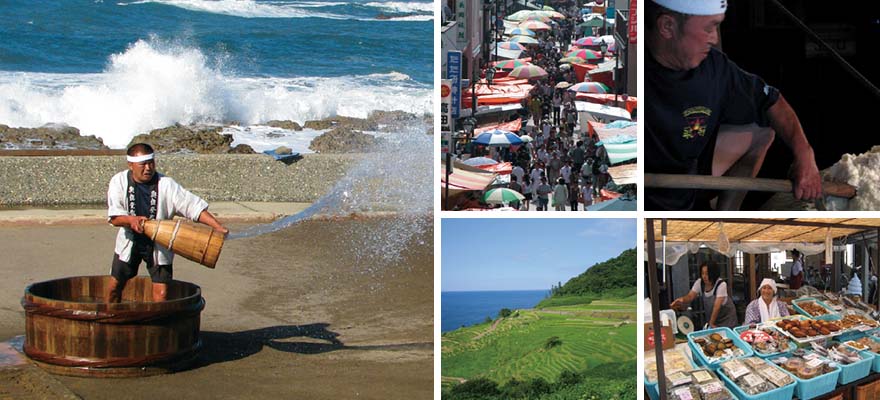Home > Highlighting JAPAN >Highlighting Japan November 2013>40th Year of ASEAN-Japan Friendship and Cooperation
Highlighting JAPAN
47 Prefectures from A to Y
ISHIKAWA
Gems of traditional crafts and foods in Wajima

DON'T let its quaintness fool you. Wedged on the Noto peninsula, the seaside town of Wajima has some of Japan's most charming cultural treasures, which you can sample in the form of food, art and the gorgeous landscape.
Asaichi morning market: Wake up to the sounds of blaring voices coming from this centuries-old morning market. Asaichi is where sun-tanned, head towel-clad women congregate early in the morning to sell products of the sea, homegrown vegetables, handmade crafts and the local nihonshu (Japanese rice wine). The generous vendors will let you try samples of dried fish, shrimp, crab, sea urchin paste, scallops and squid mixed with yuzu and koji seeds. Should you be hungry, you can even have breakfast there; just pick the catch of the day and have it grilled in the BBQ space especially arranged for meals. One of the most fascinating aspects of the market is seeing how the friendly locals interact with each other and the numerous tourists, and how traditions have survived throughout the years, complete with the obachan (elderly lady) pushing her cart, selling drinks to the busy vendors.
Lacquerware: The town of Wajima is best known for its elegant and intricate lacquerware, called Wajima-nuri. While robust in body, it is refined in appearance, bearing ornamental designs. You can try your hand at some of the techniques used for Wajima-nuri such as chinkin; using a very sharp chisel, you can carve your own designs into the lacquerware that includes chopstick sets or bowls. After lacquer is applied thinly over the material, gold leaf or powder is inlayed to bring out the design — and you can leave with your very own, custom-designed Wajima-nuri.
Rice fields: One of the most scenic places in the prefecture is undoubtedly Senmaida (literal meaning: 1,000 rice fields), which are terraced rice fields stretching down a steep slope overlooking the Sea of Japan. The fields have been nationally designated as a site of extraordinary scenic beauty, and each season brings out a different kind of splendor. You can stroll through the rice fields or simply look at them from above to catch an eyeful of the geometrical patterns formed by the terraces. Every early October, locals place thousands of candles around the fields, illuminating them at night, for a spectacular result.
Salt:Due to its proximity to the sea, Suzu city next to Wajima boasts not only seafood as a resource but salt as well. Don't leave without stocking up on the condiment and don't miss a chance to learn how the salt is extracted from the sea. At the nearby Okunoto Endenmura Museum, you can view the 500-year-old method of salt production, which is still carried out today. This hard and intensive labor can only be performed on sunny days, and very few people in the region master the art. Water is scooped directly from the sea into wooden buckets, then sprayed onto the surface of meticulously raked sand. The actual saltwater throwing is by far one of the most thrilling parts of the experience, as it's done so carefully and methodically, in an arc-like motion.
Whether you spend one or a few days in charming Noto area in Ishikawa Prefecture, the chances are you will have the opportunity to meet the local people and see and experience famous local products and handicrafts. And, year-round, you can feast on some of the best fish-based meals you will ever have in the country.
© 2009 Cabinet Office, Government of Japan






